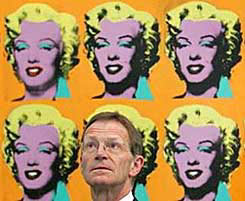The Vacuum of the Tate Ivory Tower
The famous German playwright, Bertolt Brecht, once said, “What is the robbing of a bank compared to the founding of a bank?” I wonder what Brecht would say about banks having become benefactors to today’s art museums? The Tate Modern gallery in London just recently rehung its collection at a cost of £1 million, or around $1,860,000, an expenditure underwritten by UBS – a Swiss bank and one of the largest corporate sponsors of the Tate. Interestingly enough, the giant financial institution has been given access to the Tate so that the bank can now exhibit its extensive private collection of artworks. As you might expect, having the museum exhibiting UBS’s private collection will cause the value of the artworks to skyrocket, and when the bank decides to sell its collection – more than a considerable profit will be made.

In 2000, Sir Nicholas Serota, the Tate’s director, said the ruling decree of his leadership was “simply, that we will not showcase a private collection”. If this sounds like cronyism to you, you’re not alone. Reporting on the controversy, the Telegraph quoted the co-founder of the Stuckists, Charles Thomson; “I think the Tate has tarnished its reputation so much that visitors have no idea what they are looking at any more. What is the reason for a particular work being there? Is it cronyism? Is it mercenary? Or does the work actually have any artistic value. Could I pay for a small room to house my own work? I might be able to outbid the UBS deal.”
I e-mailed Charles Thomson of the London Stuckists and asked him for more details regarding the latest controversy at the Tate, and whether or not the museum had contacted him with the going rates on renting an exhibit room. Here’s what he wrote back:
“Surprisingly the Tate has not hot-footed it in my direction with their rate card, but what is now established is that the Tate can be bought. In the current edition of Modern Painters magazine, Vincent Todoli comments that money doesn’t give power, but it does give access. Of course, access is power, so the whole thing is another Tate mincing of words, reminiscent in particular of Sir Nicholas Serota’s excuse last year for signing a false grant application for trustee Chris Ofili’s work as a ‘failing in his head’ and in general of a trip with Alice through the looking glass.
In line with this mentality Serota has downplayed the UBS presence as just three small rooms. They’re not small and they’re bang in the middle of the third floor (which is the first floor of displays at Tate Modern), i.e. a prime position. Compared to this Vuillard and Bonnard, for example, are tucked away in a much smaller side room.
What is astonishing is that it costs the Tate £1,000,000 to rehang their collection. How the hell do they manage to spend that much money? What are their numerous curators doing the rest of the time? Isn’t that their job – curating the display? Shouldn’t a rehang be absorbed into their running costs? They’ve got 21 staff earning over £50,000 – perhaps they should roll their sleeves up occasionally. Tate Modern’s 2004-2005 expenditure on staff for its ‘public programme’ was £5,775,000 but this couldn’t even accommodate trundling works in and out of storage. (Tate’s total costs for around 1,245 staff were £29,029,000.)
Tate Modern’s first hang was completely off the wall, so as to speak, and deeply unpopular. The Tate nobly advocated that they didn’t want to force the work into a curatorially-imposed straightjacket – in other words to hang it chronologically by school as museums had always done. They succeeded in imposing the straightjacket of all straightjackets by devising abstract categories according to – to what, one might ask? Words such as ‘matter’ and ‘object’ appeared in large lettering and the work was grouped idiotically according to them. If you wanted to find works by Picasso you had to search through different floors and rooms. The trouble is, you still do with the new hang, so the thing that everyone wanted still hasn’t been achieved – namely a genuinely non-curatorially imposed schema, but instead one created by the reality of history, the reality of an artist’s career and the reality of the school within which that artist worked with other artists, influencing and being influenced by them.
Serota doesn’t care much for reality. He attends to the concepts which he constructs in the vacuum of the Tate ivory tower. Just as conceptual art disenfranchises the public through its basis in inbred artworld references within references, so does this museum mentality, which one might term ‘conceptual curating’. Like conceptual art, it’s great in theory and crap in practice. So we haven’t even got our million pounds worth anyway.
Ironically the most successful parts of the new display are the most conventional, like the large room where cubist works are hung (with great daring by the £50,000 p.a. curators) with – other cubist works. Also innovative and enjoyable are some walls where works are hung in a two or three deep design, reminiscent of the old salon style and also, as more than one visitor has pointed out to me, The Stuckists Punk Victorian show at the Walker Art Gallery in Liverpool in 2004, which Serota visited and spent a long time studying. The Walker described the show as ‘a really, really popular show and very successful’. Saatchi is now an unashamed Stuckist in all but name and has embodied our ideas in stating painting is the ‘most vital’ art form, as well as creating an open access for artists to post work on his website. Saatchi is six years behind the Stuckists and Serota normally lags six years behind Saatchi, so in 2012 we might even get a hang that is really, really popular and very successful at the Tate. “



